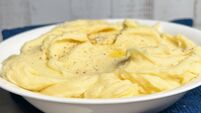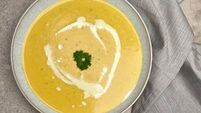Great balls of flour
Pad digging the first new potatoes in the vegetable garden 'balls of flour' he'd declare proudly, and then after the first taste he'd bless himself and solemnly mutter, 'Please God may we all be as well this time next year'.
I particularly remember a variety called Skerry Champions, yellowy flesh with dark purple eyes, I've searched high and low for seed in recent years but have never been able to find it.
I adore the ubiquitous potato, the world's favourite and most under-appreciated vegetable, which has nourished and sustained the Irish nation for hundreds of years.
We depended on it to the exclusion of everything else, with the result that when the crop failed, disaster struck in the catastrophic famines of the 1840s. The effect was incalculable, millions died or emigrated, yet the potato is still an integral part of our culture, our folklore and our civilisation. It is still not unusual to be served potato cooked in three ways as part of a meal in a country hotel mash, roast and chips.
Yet the search for a really good potato as we knew it becomes ever more difficult, many old varieties are lost, their low yields meant that they were not commercially viable, consequently they were disregarded in an ever intensifying battle to compete against cheap imports. Sadly, many Irish potato growers got locked into an impossible Catch 22 situation. In a desperate effort to boost yields, they increased the nitrogen levels, but the resulting potatoes, although bigger had less flavour, and kept less well. The Irish housewife increasingly turned to pasta and rice as they tired of having to discard a percentage age of almost every bag of potatoes.
It's like everything else, if we want potatoes like 'they used to be' we need to seek out old varieties, and farmers who use little or no nitrogen, and most importantly we need to pay them more because really good Irish potato varieties yield less but taste better. Look out for British Queens, Kerrs' Pink in August and floury Golden Wonders in September. If you are fortunate enough to have a farmers' market in your area, you may find a passionate grower with small quantities of splendid old varieties. I particularly love Pink Fir Apple and Sharpe's Express. Recently in the Skibbereen Market I bought a few pounds of Ratte, Desiree and Charlotte and we simply had potatoes for supper with lots of butter and flakes of Maldon sea salt.
The Ballycotton area has long been famous for its potatoes. If you'd like to taste an almost forgotten flavour, call to Patrick Walsh's farm in Shanagarry, Co Cork, or join the queue around Willie Scannell's stall in the Midleton Farmers' Market every Saturday from 9am-1.30pm.
Alison Henderson's Ardsallagh goat's cheese, potato and mint tart
THIS gorgeous quiche is a permanent favourite at the Ballymaloe Shop Café
Serves: 6-8
Savoury pastry (makes enough to line two deep 30cm (11inch) tart tins)
285g (10oz) plain flour
170g (6oz) butter, chilled and diced
pinch of salt
2 teaspoons of icing sugar
1 free range egg, beaten
Filling:
200g (7oz) Ardsallagh Goats Cheese
6 free range eggs, beaten
12 waxy, new potatoes, boiled
small tub of cream 170ml (¼ pint approx)
170ml (¼ pint approx) milk
bunch of fresh mint, chopped
salt and freshly ground pepper
1 x 28cm (11inch) tart tin
Preheat oven to 180C/350F/gas 4. Pulse the top 4 ingredients in a food processor until they resemble coarse breadcrumbs. Add the egg and pulse again until the mixture begins to come together. Then tip the dough onto a piece of cling film. Shape into a log, wrap and refrigerate, preferably overnight. The next day line the tart tin with the dough and blind bake, (without foil or beans) at 200C/400F/gas 6 for 5-6 minutes. Keep an eye on it and remove from the oven before it dries out too much. If it fissures it can be patched, but this quiche mix is quite thick so it shouldn't ooze too much anyway.
Boil the potatoes until cooked. Drain and set aside. Cut the goats cheese into cubes 1 cm (½ inch) approx.
Mix the eggs, milk, cream, mint, salt and pepper in a bowl. Let stand 15 20 minutes to allow the mint to infuse the custard mix.
To assemble: Halve the cooked potatoes. Line the tart base with the potatoes and cubed goats cheese. Pour the custard mixture into the tart, not totally covering the potatoes. Allow them to jut out of the mixture. Bake in a preheated at 180C/350F/gas 4 for 25-30 minutes until set and golden round the edge. Allow to cool slightly. Serve with a good green salad and Cranberry sauce.








